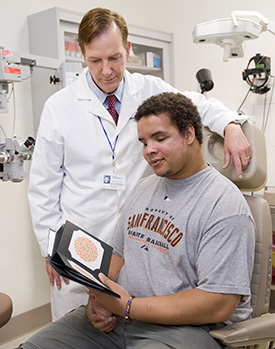Office of Research & Development |
 |
Office of Research & Development |
 |
September 21, 2018

Physician-researcher Dr. Glenn Cockerham meets with Marine Veteran Jason Poole. (Photo: VA Palo Alto Healthcare System)
A 2011 study at the VA Palo Alto Health Care System found that many Veterans who have had traumatic brain injuries also have "hidden eye injuries" that may go undetected without comprehensive eye examinations.
The researchers evaluated 46 combat Veterans with TBIs from blast injuries who had not previously reported any eye injuries. Of that group, 20 (43 percent) suffered what ophthalmologists call "closed eye ocular injuries"—injuries that do not actually penetrate the eye.
They recommended that any patient with a TBI diagnosis, including those without current vision problems, have a comprehensive eye examination by an ophthalmologist to check for hidden eye injuries that may cause future problems such as glaucoma.
As a result, the Vision Center of Excellence, operated jointly by VA and the Department of Defense, has provided clinical recommendations to guide optometrists and ophthalmologists in treating patients following a possible TBI or blast exposure. The recommendations include tests to help screen for the most common ocular injuries, as well as vision problems caused by or associated with TBI.
In 2013, the Palo Alto research team led a study that developed a clinical tool that can be used by eye-care providers either as a screening tool or as part of a full eye examination when they see a patient with a history of mild TBI. It includes guidance for collecting a history of the patient's experiences and for measuring vision function. This tool is now being used throughout VA and DOD.
Principal investigator: Gregory L. Goodrich, Ph.D.; VA Palo Alto Health Care System
Glenn C. Cockerham, M.D.; VA Palo Alto Health Care System
Selected publications:
Development of a mild traumatic brain injury-specific vision screening protocol: A Delphi study. Goodrich GL, Martinsen GL, Flyg HM, Kirby J, Asch SM, Brahm KD, Brand JM, Cajamarca D, Cantrell JL, Chong T, Dziadul JA, Hetrick BJ, Huang MA, Ihrig C, Ingalla SP, Meltzer BR, Rakoczy CM, Rone A, Schwartz E, Shea JE. J Rehabil Res Dev. 2013;50(6):757-68.
Mechanisms of TBI and visual consequences in military and veteran populations. Goodrich GL, Flyg HM, Kirby JE, Chang CY, Martinsen GL. Optom Vis Sci. 2013 Feb;90(2):105-12.
Closed-eye ocular injuries in the Iraq and Afghanistan wars. Cockerham CG, Rice TA, Hewes EH, Cockerham KP, Lemke S, Wang G, Lin RC, Glynn-Milley C, Zumhagen L. N Engl J Med. 2011 Jun 2;364(22):2172-3.
Prevalence of dual sensory impairment and its association with traumatic brain injury and blast exposure in OEF/OIF veterans. Lew HL, Pogoda TK, Baker E, Stolzmann KL, Meterko M, Cifu DX, Amara J, Hendricks AM. J Head Trauma Rehabil. 2011 Nov-Dec;26(6):489-96.